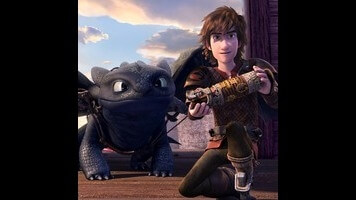Dragons: Race To The Edge continues its impressive quest to adulthood

Dreamworks’ Dragons, now streaming on Netflix after jumping over from Cartoon Network, holds up as one of the only examples of an animated TV series that nearly rivals its cinematic versions (which were based on a wondrous YA book series by Cressida Cowell). The movies’ main voice actors (Jay Baruchel, America Ferrera) are still on board, which eases this transition, and the animation reaches the high standards set by the films: Witness a huge horde of small dragons flying in formation to resemble one huge dragon.
Dragons: Race To The Edge continues the series’ main quest: It uses young hero Hiccup’s examination of the world around him as an allegory for growing up. At first he was an outcast and rebelling against his father, like most teens. Now, as a young man, he longs to leave Berk and explore, entreating clan healer Goethe that she must “remember what it was like to be my age… the need to explore and see what else is out there… to get answers to questions you haven’t even asked yet.” If only we all had a friendly dragon like Toothless to soar on to get us through our road to adulthood, but Hiccup’s Viking journey makes complete sense in terms of his adolescent parameter. Hiccup navigates his growing-up adventures the same way high schoolers must commandeer the perils of an unfamiliar lunchroom or a gym-class bully.
Unfortunately, the series’ time parameter doesn’t hold up quite as well. This season takes place a year before the excellent How To Train Your Dragon 2, so there is a major gap between the movie and the series in terms of the loss of one of the main characters. The movie sequel occurred five years after the original How To Train Your Dragon; Race To The Edge picks up three years after last year’s Riders Of Berk (which followed the previous season, Defenders Of Berk). The Viking civilization has lived in peace all this time, and Hiccup’s nefarious brother Dagur The Deranged (David Faustino, sounding like a baby David Cross) has been locked up. Secure yet complacent, Hiccup looks on as his friends all find different interests, be it weaponry (Snotlout) or trickery (twins Tuffnut and Ruffnut). As he always has, Hiccup just wants to study dragons. After Dagur’s escape, Hiccup gains his father’s approval to go out and search for more species, spurred on by the discovery of the mysterious lantern stick Dragon Eye, which reveals that they are further dragons to be explored.
The first few episodes pack an amazing amount of cliffhanger activity into their 20-some minute segments. An encaged crew is headed toward eel-infested waters on a sinking ship; nasty dragon Deathsong encases the riders and their dragons in some kind of clear orange gel that hardens into stone; a sea serpent proves to be as formidable in the water as any of the dragons are in the air. These dangerous scenarios would play just as well on the big screen. Impressively, the show weaves its themes and moral structures within these hair-raising situations. As the efforts of all the small dragons combine to create a convincing menacing threat, Hiccup realizes that he’ll need the merged ideas of all his friends to build his new exploratory colony, which he’s named Dragon’s Edge. Or Fishlegs comes to understand that it’s always better to be yourself, even if your other self is a conqueror named Thor.
This kind of momentum across two movies and three TV seasons is impressive, vaulting over any possible slump. The quick scripts offer a few movie references that kids won’t catch but their parents will (Raiders in “Why did it have to be eels?”; The Godfather in “You broke my heart, Thor. You broke my heart.”) Sure, an episode where Fishlegs has allergies slightly pales in light of the more exciting dragon explorations. But even the slower segments are augmented by our now-infrequent visits back to Berk, as when Gobber does a predictably horrendous but hilarious job taking over for Goethe the healer, concocting some of the most disgusting animated elixirs ever seen. And the riders’ entertaining wisecracks and distinct personas prevail, from courageous Astrid to the mischievous Snotlout: And who knew Tuffnut would make friends with a chicken?
It would be nice if the Dreamworks team could come together to make the timeline less jarring. But if we just concentrate on Race To The Edge on its own, the series contains plenty of entertaining fodder to help us focus less on pesky timeline glitches. Hiccup and his friends have traveled from adolescence now to the brink of young adulthood, and it’s exciting to see the inroads they make. Faustino has his work cut out for him to maintain a Berk foe as treacherous as the previous season’s Alvin—voiced by king of all animated villains Mark Hamill—but his sibling-based jarring fits right in so far. Most importantly, as Hiccup learns how to lead throughout the series, he’s realizing that the best way to do this is not by command, but by letting the rest of his team step up: a valuable lesson for any wannabe leader.